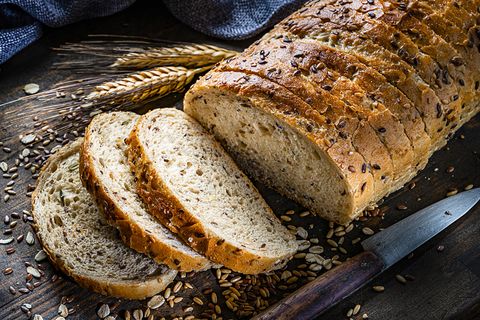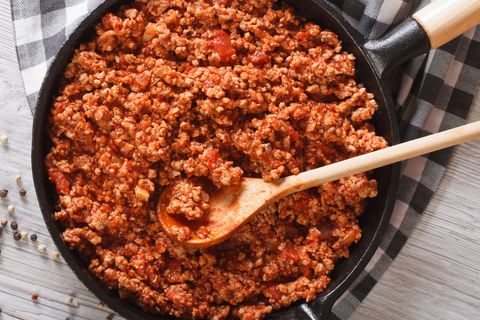How to Choose Healthy Foods
On paper, eating healthy should be as easy as strolling through a park on a sunny day, but it’s actually more like maneuvering through a nutrition minefield—something you can blame on savvy packaging and marketing that positions certain products as being better for you than others.
When grabbing packaged foods adorned with words like “fruit,” “vegetable,” “whole grain,” or “high protein,” on their labels, it’s natural to assume they will offer you some level of added nutrition.
The reality, however, is that a number of these foods benefit from an undeserving health halo that can easily make them appear better for you than they actually are. If you aren’t careful, this healthy-seeming trap could end up undermining your training.
To make the best dietary choices, it’s helpful to get wise about what is actually healthy and what is mostly food marketing hype.
We dug into several food labels and chatted with dietitians to suss out some of the biggest health food impostors in the supermarket—and how to choose actual healthy foods instead.
1. Whole-Grain Bread
If you aren’t careful, you could easily be duped into thinking you’re eating more whole grains than you actually are. Breads, tortillas, and bagels touting slogans like “made with whole grains,” “7-grain,” “multi grain,” “pumpernickel,” or “gluten-free” are often refined grains in disguise.
“Consumers can’t depend on these labels meaning ‘whole grain’ unless they check the ingredient list,” Bonnie Taub-Dix, R.D., author of Read it Before You Eat It, tells Runner’s World. “Multi grain, for example, just means many grains are in the product and may or may not contain whole grains.” In other words, your lunch sandwich made with healthy-sounding 7-grain bread could feature mostly refined white flour.
There could be some health impacts when skimping on whole grains, like whole wheat bread. An investigation in The BMJ found that adults with high consumption of refined grains had a higher risks of cardiovascular disease and early death, as well as increased systolic blood pressure, compared with those who typically consume low amounts of refined grains. “Whole grains contain the whole grain—the bran, endosperm, and the germ—providing more nutrients and fiber,” Taub-Dix says.
To make sure you are making your breakfast toast or midday sandwiches with a healthier option, Taub-Dix says you want to flip the package over to see where whole grains appear on the ingredient list.
“Choose those products that list whole grains as the first grain ingredient,” Taub-Dix says. So, this should be a whole flour like whole wheat flour or whole rye flour/meal, rather than wheat flour, which is just a euphemism for white flour. This way, you get more fiber and a greater range of essential vitamins and minerals. A label that states “100 percent whole grain” cannot include any refined flour.
If shopping for gluten-free beads, Taub-Dix says you’re looking for options that lead with gluten-free whole-grain flours, such as brown rice, oat, amaranth, or sorghum instead of less nutritious ingredients like rice flour or tapioca starch.
2. Flavored Greek Yogurt
Packed with protein, calcium, and probiotics, Greek yogurt is a standout nutrition citizen. However, if you’re not careful, your favorite fruit yogurt could be sullied by surprisingly high amounts of added sugar—a.k.a. sugar that hails from sources other than what is found naturally in dairy (lactose) and fruit. Berry, vanilla, and other flavored Greek yogurts may sneak in three times as much sugar compared to plain versions.
Research has not been kind regarding the role consuming too much added sugar in your diet has on health outcomes. For instance, a report in the journal Open Heart suggests taking in high amounts of added sugar can drive up the chances of developing heart disease.
The American Heart Association suggests men and women should cap their intake of added sugars to 9 teaspoons (36 grams) and 6 teaspoons (25 grams) daily, respectively. A 6-ounce serving of berry flavored yogurt can deliver up to 15 grams of the added stuff, so it can put a big dent in your daily allotment if you’re not careful.
Taub-Dix says a smart move would be to select plain versions of Greek yogurt and sweeten them with berries or other chopped fruit. “Adding your own fresh fruit is beneficial for many reasons: You’ll get less or no added sugar, and you’ll get the benefit of the multitude of nutrients within the fruit.” She suggests pureeing your own fruit and stirring this into yogurt if you want the fruit to be better distributed throughout.
If you enjoy the flavor of vanilla yogurt but not the sugar it usually comes with it, simply stir a couple of dashes of pure vanilla extract into your yogurt bowl. If you just can’t bear to part with fruit flavored yogurts, Taub-Dix recommends looking for brands that list real fruit before any sugars in their ingredient list and contain no more than 5 to 7 grams of added sugar in a serving. (FYI: Added sugar levels in grams are now stated on nutrition labels.)
3. Veggie Chips
They’ve got “veggie” in the name and vibrant vegetable photos on the packaging, so they must be better for you than potato chips, right? In reality, some veggie chips are simply vegetables, such as sweet potatoes or beets, that are baked with some fat and seasoning until crunchy and then packaged up.
“Vegetable chips that list vegetables as the first ingredient do have a nutrition edge over standard potato chips, as they contain the fiber and phytonutrients found in the fresh vegetable,” says Leslie Bonci, M.P.H., R.D.N., C.S.S.D., owner of Active Eating Advice. “But they can be lower than fresh [vegetables] in certain nutrients, like vitamin C, and are more calorie-dense as they do not have the water content and come with added fats.”
In other words, just because they are made with vegetables doesn’t mean they’re an adequate substitute for fresh versions. “A problem arises when people end up eating more than an appropriate serving,” Bonci says.
Another category of veggie snacks are packaged sticks and puffs that are typically made with potato starch and potato flour (or cassava flour), vegetable oil, and some spinach or other vegetable powder as almost an afterthought in the ingredient mix.
“Many people will eat these and think they are having a serving of vegetables and the nutrients they contain, when in fact they are just getting a serving of nutrition-poor starchy carbs,” Bonci says. Often, they have a fewer calories and grams of fat than regular potato chips, but sometimes they deliver more sodium than their spud counterparts. If you want to get an actual veggie boost in your diet, look for ways to incorporate whole vegetables into your snacking routine—baby carrots with some nuts or sliced peppers dunked into hummus fit the bill.
4. Ground Chicken
If you’re choosing ground chicken as an alternative to beef—since it can be used in many of the same ways—you might be getting a lot more calories and saturated fat than you hoped for. That’s because products labeled “ground chicken” or “ground turkey” can include some higher fat skin and dark meat in addition to leaner white breast meat, according to Taub-Dix.
A 3-ounce serving of regular ground chicken can have 10 grams of fat or more compared to just a couple of grams of fat in ground chicken breast. That means more saturated fat in your meat sauce or chicken burgers, which is something worth paying attention to: Reducing your saturated fat intake from meats, while replacing these calories with polyunsaturated fats from plant foods like nuts and seeds, is a recipe for better heart health long-term.
“You can look for the words “extra lean” on the label when purchasing ground poultry, which means you are only getting the leaner breast meat,” says Taub-Dix. That means the ground meat will have a nutritional value very similar to whole breast meat—lots of protein and low amounts of saturated fat.
Sometimes the ingredient list will indicate that only the breast meat was used. Another indicator of leanness is color: In cases where the manufacturer uses fattier parts of the bird, the resultant hue of the ground meat will be that of dark pink and have a lower lean percentage of around 80 to 85 percent. If the manufacturer uses all or nearly all white breast meat, the shade will be a light pink, and the meat will have a high lean percentage— typically 95 percent or more.
5. Protein Cookies
The main selling feature here is that with a lot more protein and fiber—up to 15 and 10 grams per cookie, respectively—these are cookies are often considered a healthier choice than your mother’s chocolate chip recipe. However, calorie and sugar counts are typically high, at 250 calories and 15 grams sugar or more per cookie, and many brands use refined grains as their base.
“Since some of these are really high in calories, they may list a serving as half of a cookie, which few people are likely to limit themselves to,” Bonci says.
Protein typically comes from the inclusion of whey or a plant-based protein like pea, but Bonci stresses that we shouldn’t be looking to get our protein from packaged baked goods —instead, we should get our protein from more nutritious whole foods like poultry, dairy, eggs, and legumes. Besides, few runners are taking in low enough amounts of protein that necessitate the need to get more from a cookie.
Bonci adds that taking in high amounts of the non-digestible types of fiber, like chicory root, in these products can cause GI distress if you’re not used to them. “If you have one of these before your run, you may be done before you start if you end up with digestive issues,” she says. Some brands use sugar alternatives like erithrytol and monk fruit extract, but these can impart unappetizing flavors.
With that said, if you’re recovering from a hard workout, Bonci agrees that these non-perishable modified cookies have the carbs and protein needed to help with muscle recovery.
This content is created and maintained by a third party, and imported onto this page to help users provide their email addresses. You may be able to find more information about this and similar content at piano.io










